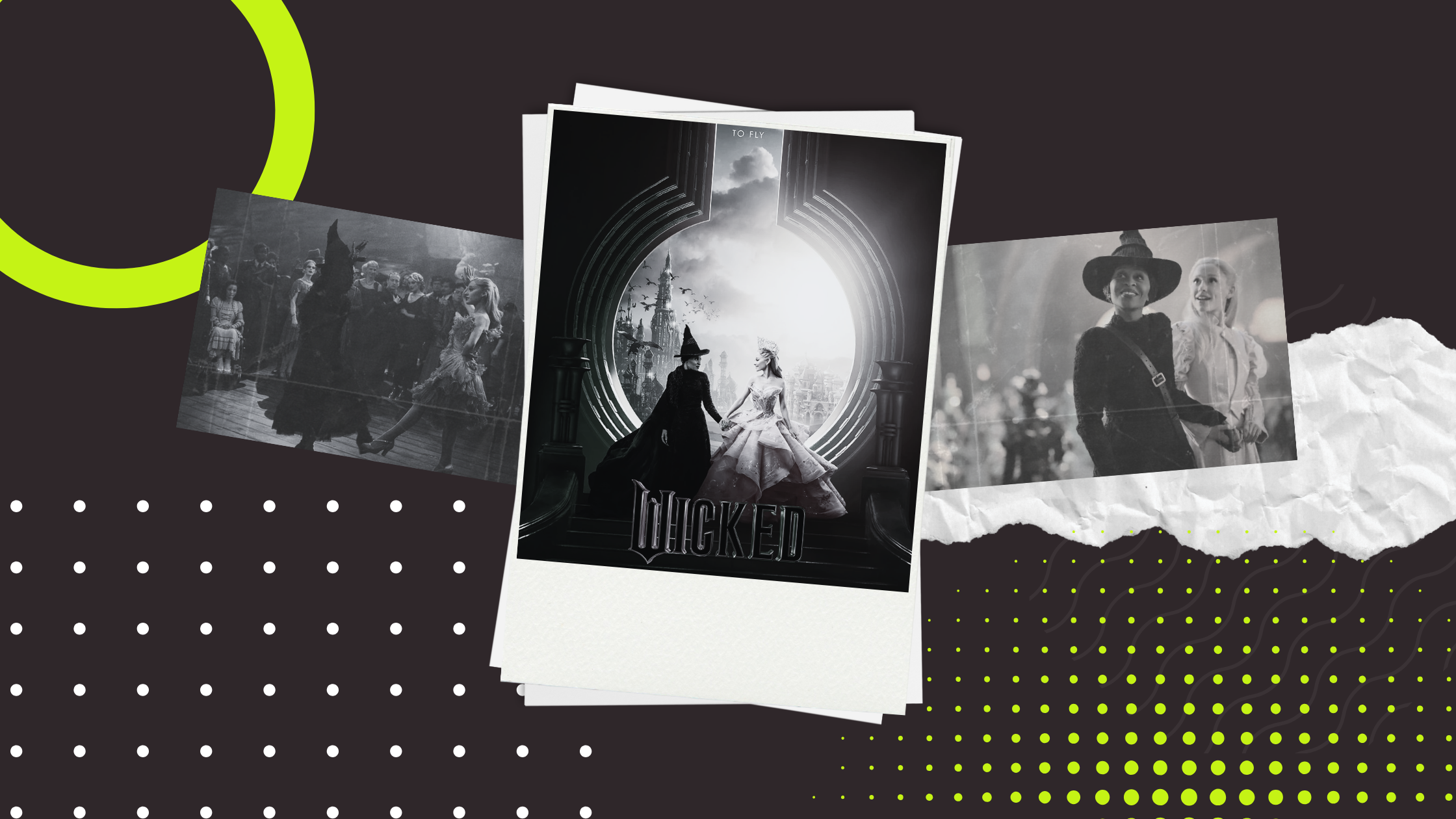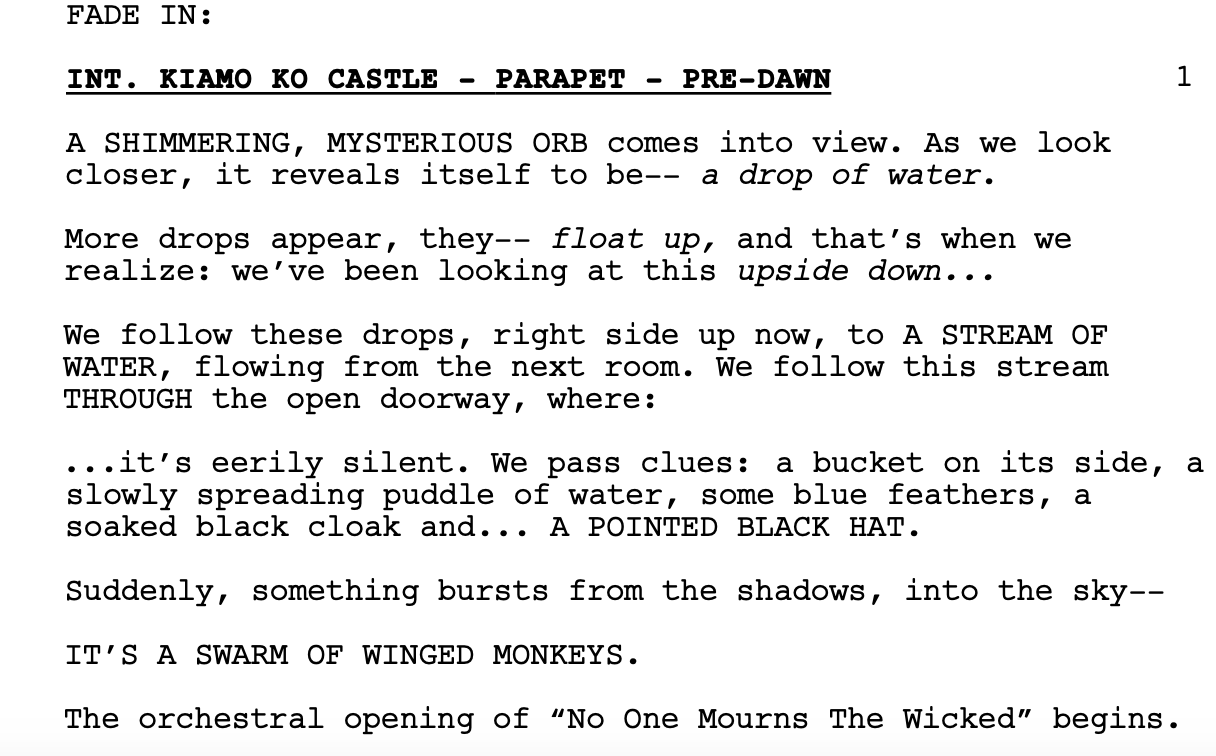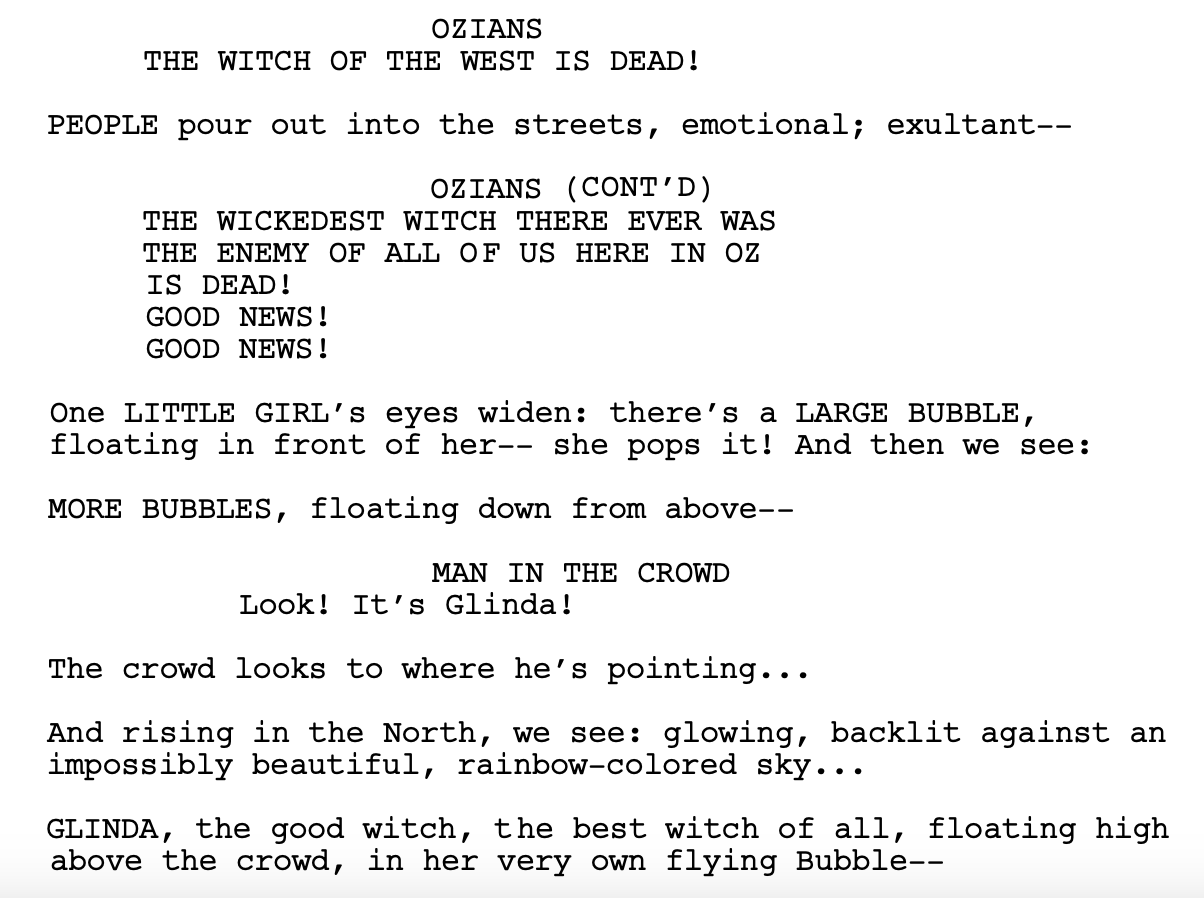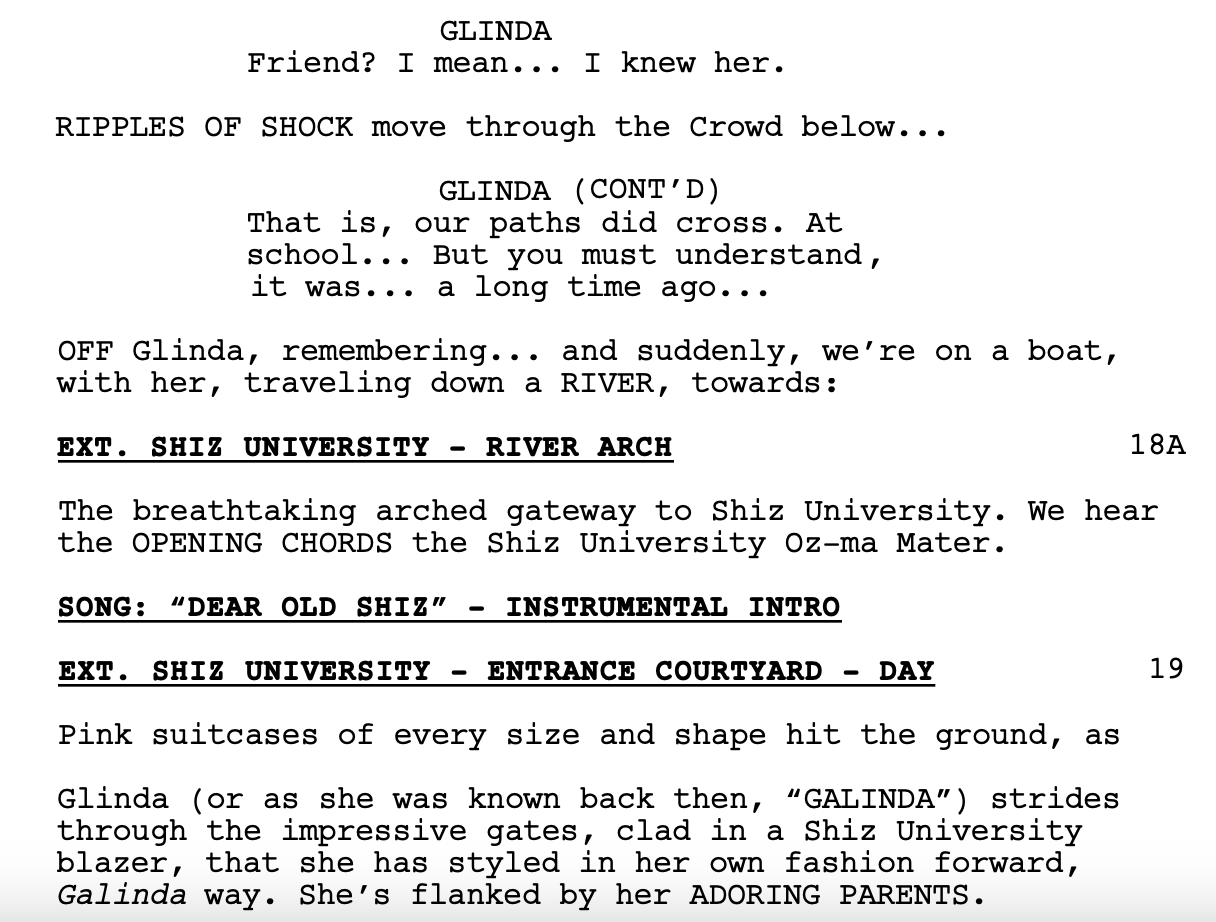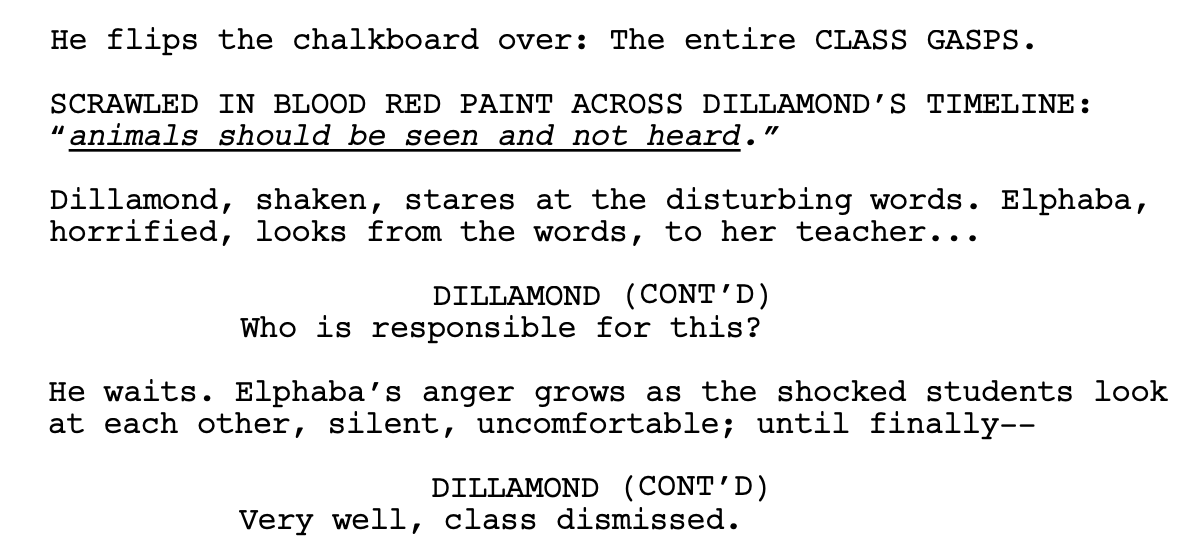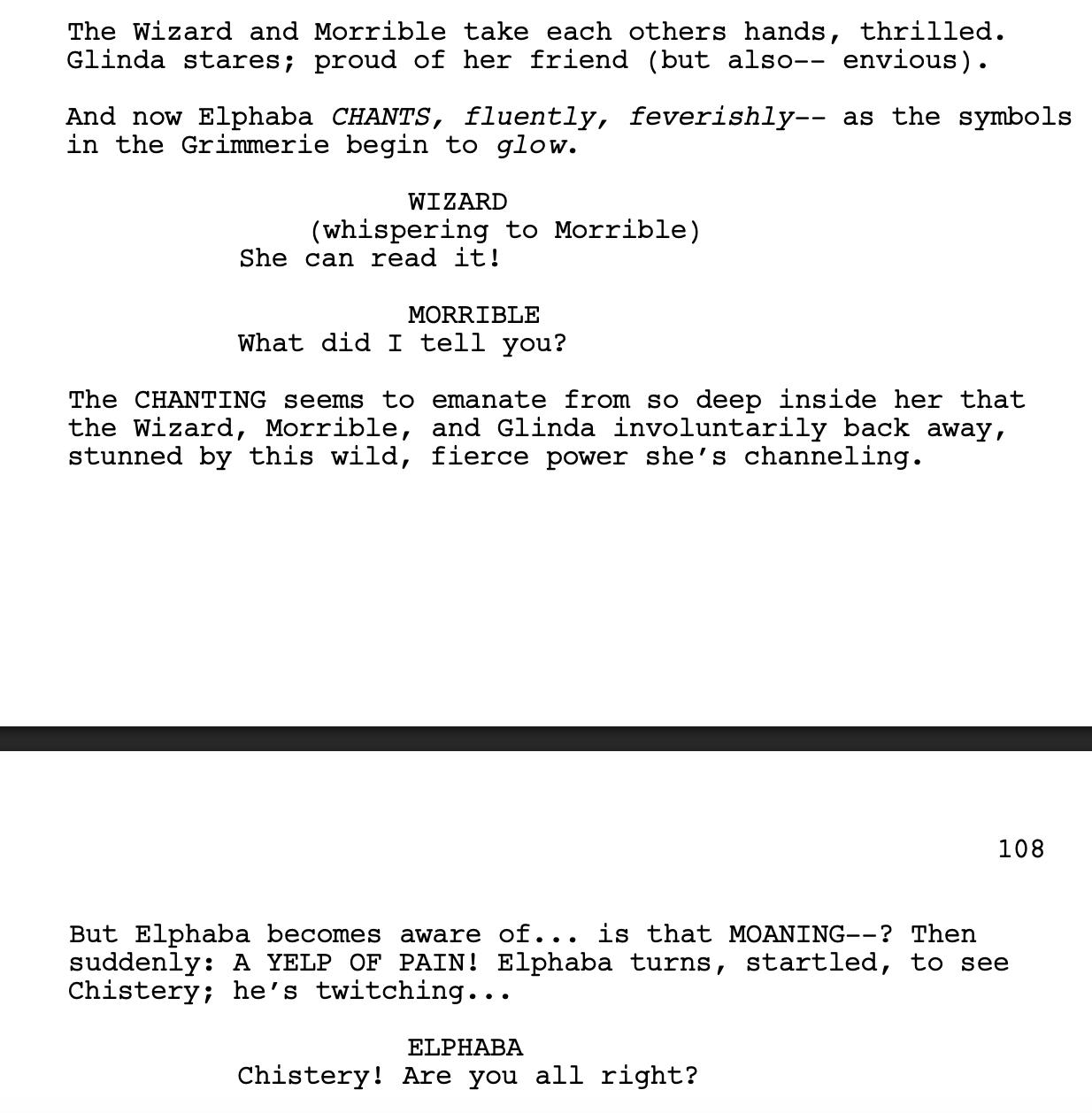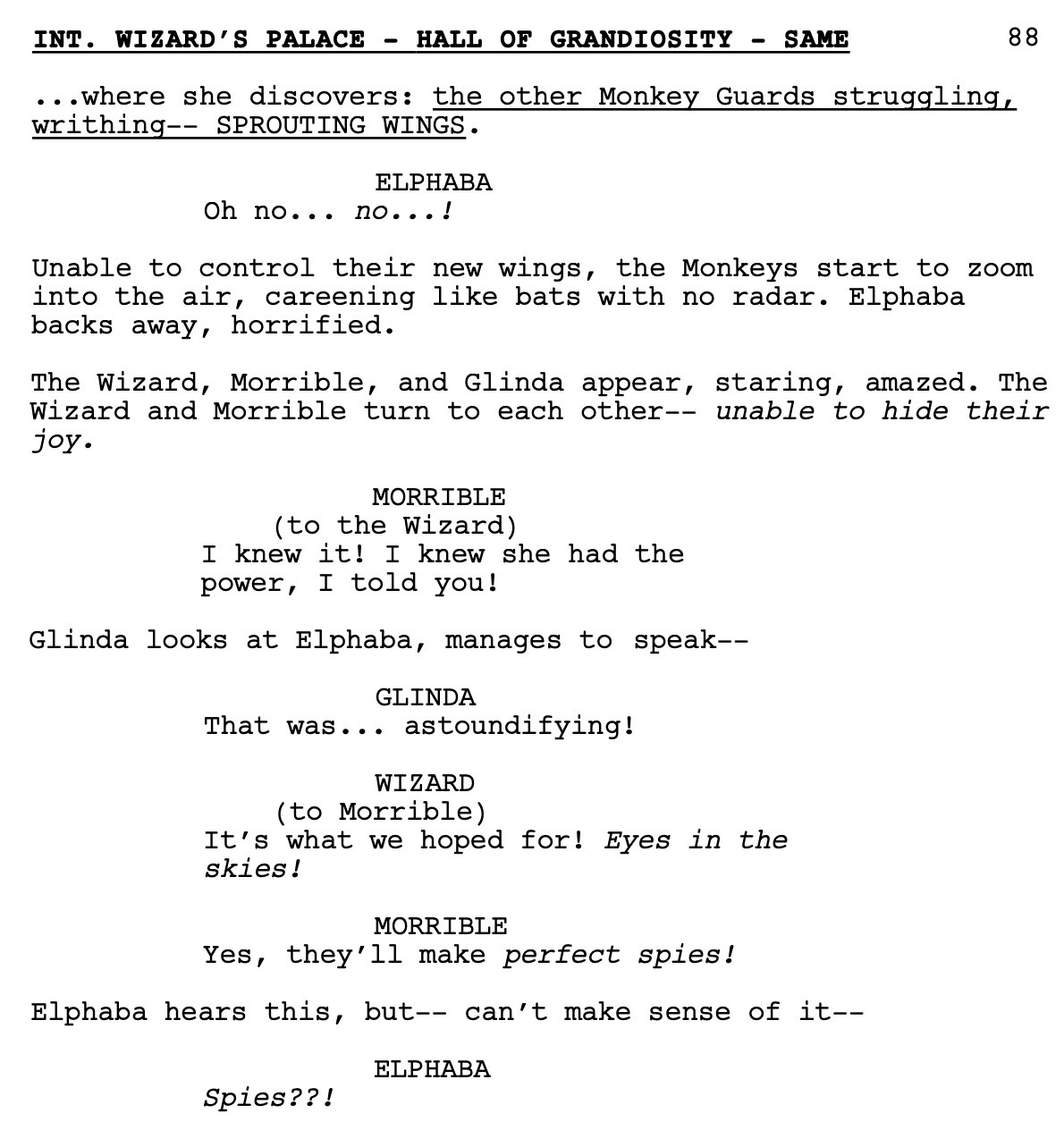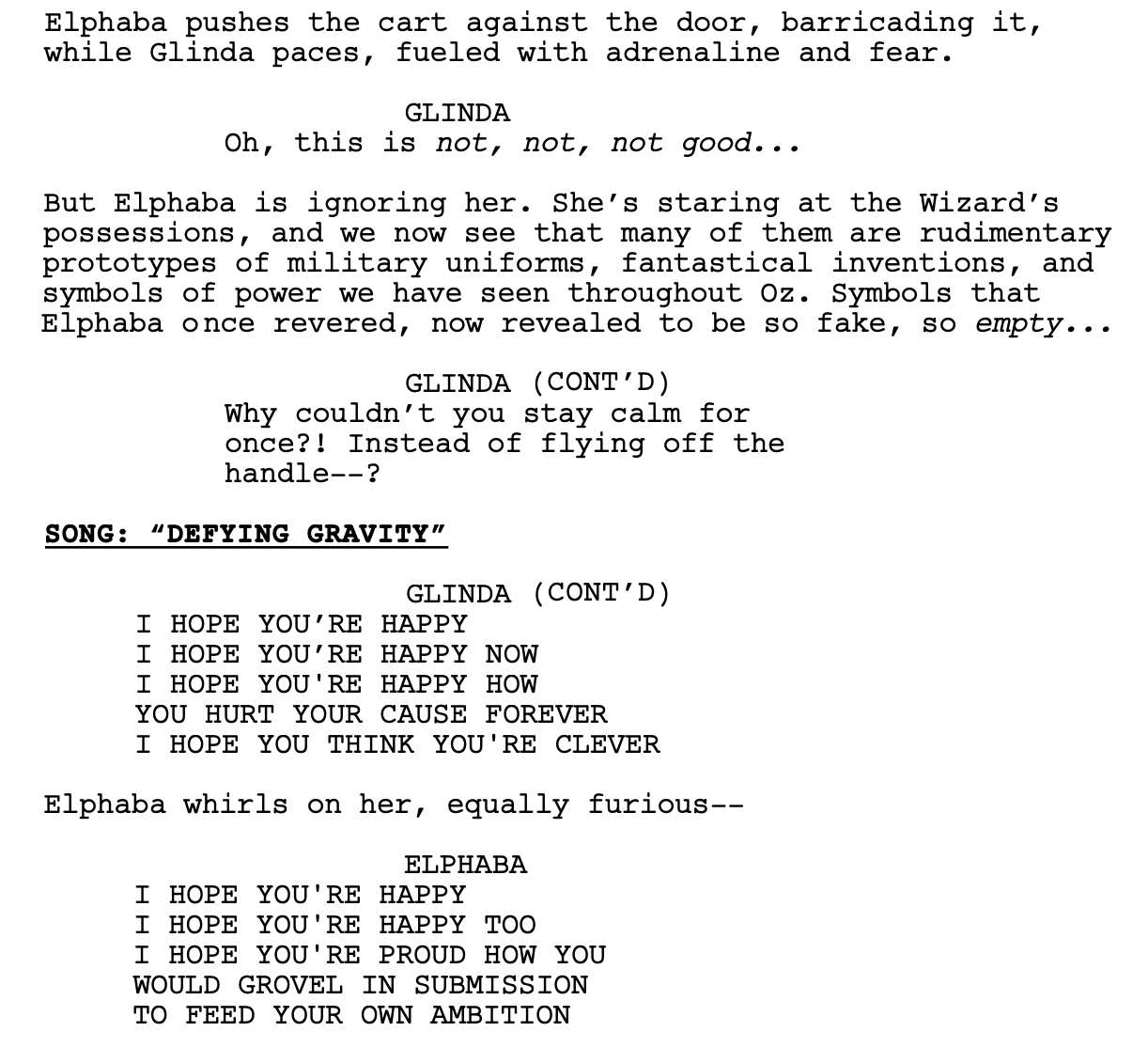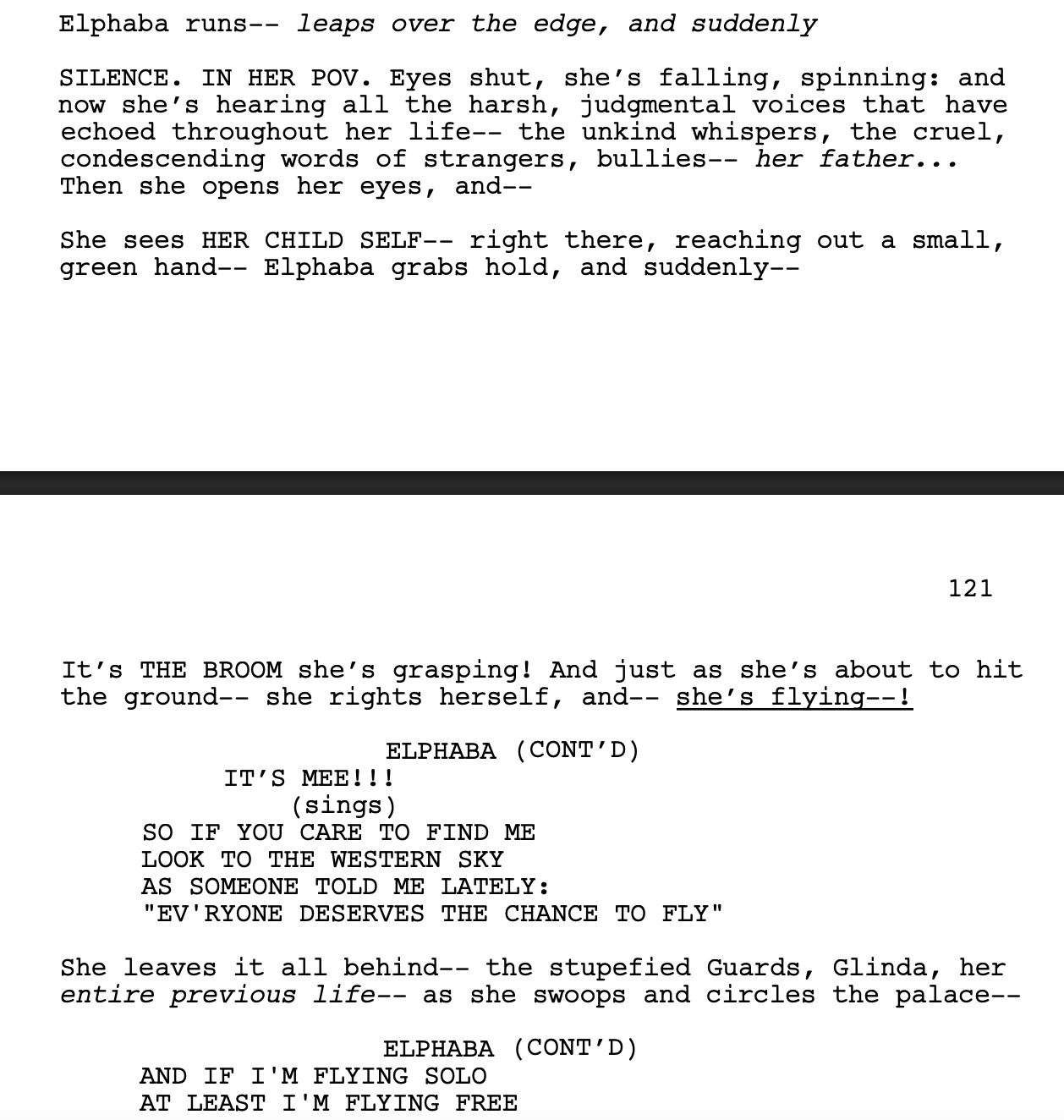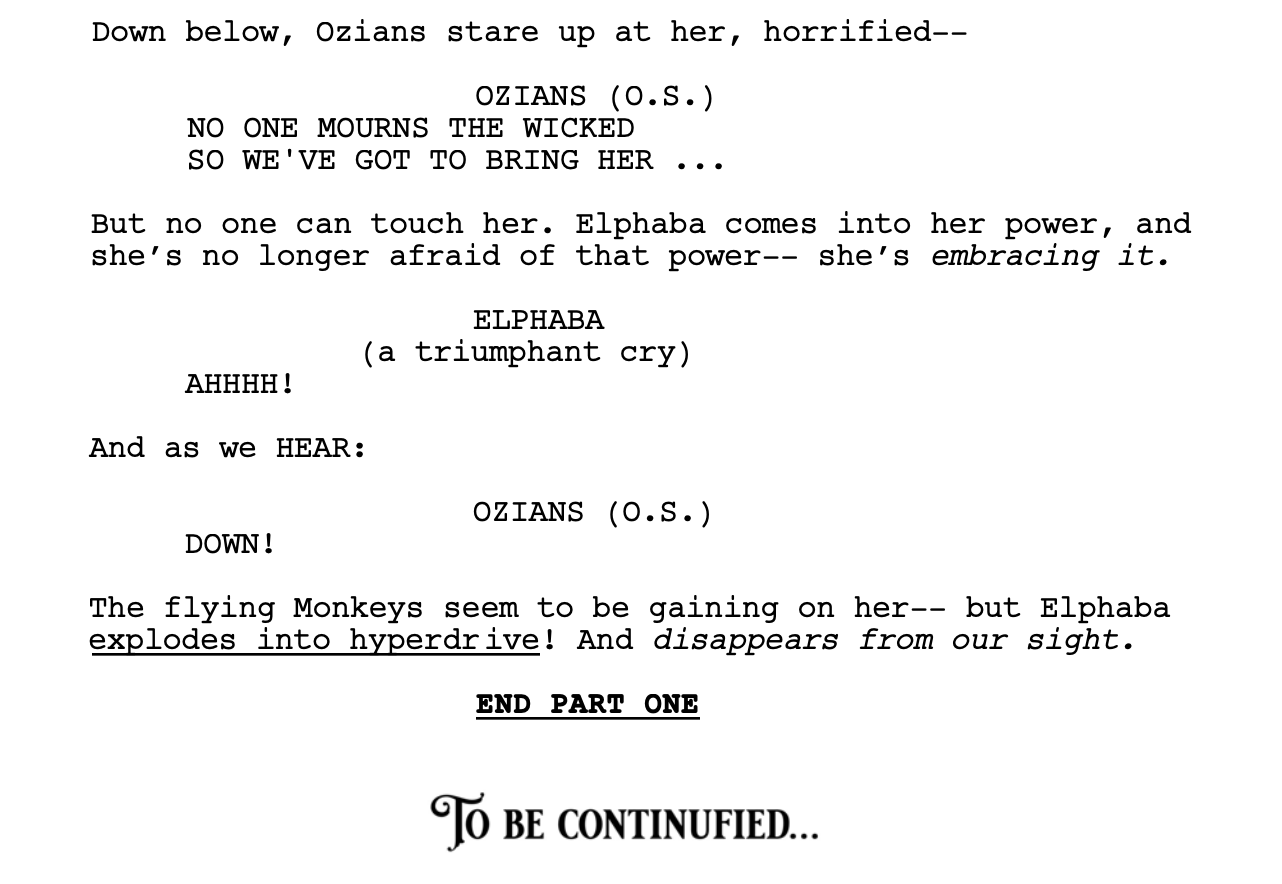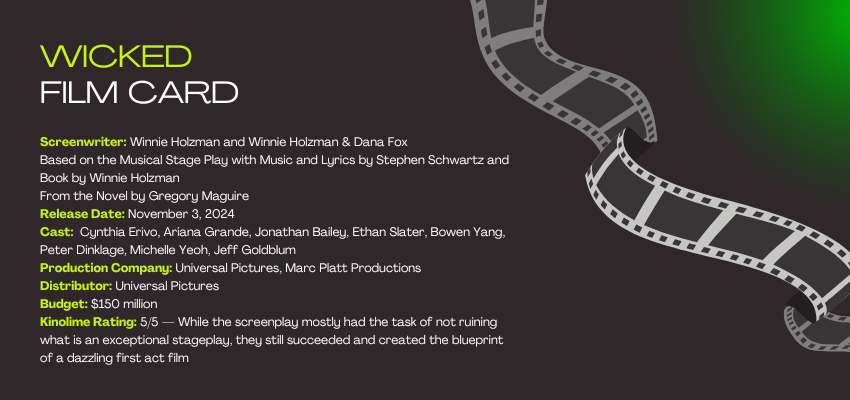Defying Expectations: A Script Analysis of Wicked (2024)
The 2024 musical film Wicked, directed by Jon M. Chu, is beautifully faithful to the first act of the popular Broadway musical of the same name while adding context and nuances for the medium. The film opens as the musical does — with the announcement of the death of the Wicked Witch of the West; although while the play begins in Munchkinland, the first visuals of the film are of the tower where the Wicked Witch was killed in The Wizard of Oz.
OPENING IMAGE
Because the source material is so iconic and well-known, there are some moments where details are omitted. On page one, the screenwriters refer to “four figures” crossing the drawbridge of the castle — onscreen these are of course The Wizard of Oz characters Dorothy, Scarecrow, Tin Man, and Lion.
Another mysterious figure is seen riding a horse — their identity is meant to be revealed in the forthcoming story, so it makes sense that they are kept cloaked in mystery. It’s an interesting choice of the writers to keep Dorothy and company anonymous in the screenplay while Chu visually embraced the iconic imagery and timed it with the change of the opening score.
The following scene is the celebration in Munchkinland following the news of the demise of the Wicked Witch of the West. The screenwriters do not refer to the songs being sung — instead, they format the lyrics as dialogue but in all caps.
Note the description when we first meet Glinda: “GLINDA, the good witch, the best witch of all.” Even if we weren’t already familiar with the Witch of the North, this cheeky description would tell us quite a bit.
Wicked opens with the present day and then cuts to a flashback, a popular way to tell an origin story (and one that can be overdone, which means emerging writers should be very mindful about utilizing the technique). Glinda offers a brief summary into the childhood of the Wicked Witch — her mother had an affair with a mystery man who gave her green tonic, resulting in her green skin and estranged family.
The opening songs offer thematic questions for the story to follow, especially are people born wicked or do they have wickedness thrust upon them? Unasked is who decides what is wicked and what is good?
But back to Munchkinland. The Wicked Witch is dead..but Glinda, the good witch, was — gasp — her friend? How could that be? Well, it all began when Glinda and the Wicked Witch were schoolmates.
Here, the story goes back in time — though note how the screenwriters do not indicate specifically, such as with a slugline, except to note that Glinda was remembering and by referring to her “as she was known back then”: GALINDA.
Galinda was beloved and popular from the moment she arrived. The Wicked Witch, with her shocking green skin, however, was decidedly not.
Finally we are introduced to our true heroine, not by her propaganda epitaph, but her name: ELPHABA (20s, badass. Her razor sharp mind and tongue serve as armor, to protect her tender soul from moments like these). Elphaba arrives at Shiz with her younger sister, “NESSA. Now also in her 20’s; Nessa is beautiful, seemingly shy compared to Elphaba, but with her own brand of inner fierceness.” Again, the writers omit the very important information that Nessa uses a wheelchair.
Nessa’s chair has defined her for her whole life, just as Elphaba’s green skin has defined her. Worse, Elphaba’s father blames her for Nessa’s condition, as their mother ate milkflowers during her pregnancy with Nessa with the hopes that their child wouldn’t also be green. Nessa is constantly babied, with Elphaba feeling responsible for her.
When the Head Shiztress, Miss Coddle, forcefully tries to wheel Nessa to her room, Elphaba’s magic surges, elevating Nessa above the crowd and drawing unwanted attention to both Thropp sisters. Most notably, Madame Morrible recognizes in Elphaba true magic and decides to take her on as a student.
Thus, Elfie is enrolled in Shiz under the tutelage of Madame Morrible — a position Galinda is envious of. Happenstance places Elphaba as Glinda’s roommate, and the game is afoot.
INCITING INCIDENT
The girls begin as rivals, with Glinda bullying Elphaba and orchestrating her ostracization at Shiz. In class, we learn that Oz is not as perfect and peaceful as it seems: after a Great Drought, food became scarce, and talking Animals became the victims of oppression. Their history teacher, Doctor Dillamond — a goat — lectures until he is interrupted by the discovery of a hate message written on the chalkboard.
Later that night, Elphaba visits Doctor Dillamond and finds him in a meeting with other Animals who are part of a resistance movement. She doesn’t know it yet, but this will plant a seed in her mind that will lead to her own rebellion.
If one were paying close attention — or perhaps was already familiar with the play and the book — one might notice that the writers are subtly offering information to the audience. Madame Morrible demonstrates her skill in manipulating the weather. In history, the students learn that the Great Drought led to the civil rights upheaval in Oz. Coincidence?
During her private tutelage with Madame Morrible, Elphaba demonstrates a pattern: her magic bursts out when she feels strong emotions. When venting about the injustice against the Animals, Elphaba levitates a coin and shoots it across the room. Madame Morrible takes note.
FUN AND GAMES
With the arrival of the “strikingly beautiful” young Prince Fiyero Tigelaar, the students are abuzz (all with the exception of Elphaba, of course, who ran into him on his way to Shiz and was the first girl to be unimpressed by him) — none moreso than Glinda, who decides right away that they’re gonna get married. Fiyero stirs up the student body and convinces everyone to sneak out to the Ozdust Ballroom for some dancing.
Interestingly, the screenwriters included a joke that plays as an Easter Egg to the famous Wizard of Oz lines “Lions and tigers and bears! Oh my!” The joke was omitted in the final film, perhaps for the best. Star Wars has shown us how easy it is to overdo a callback (how many of the spin-offs have used the line “I have a bad feeling about this…”?).
Glinda, in pursuit of Fiyero, hands off the pining Munchkin Boq to Nessa for the dance, giving Nessa the chance to have a date and true fun for the first time in her life. Glinda also gives Elphaba what will become her iconic black witch hat, under the guise of being friendly. Seeing it as an olive branch, Elphaba asks Madame Morrible to accept Glinda into her sorcery tutelage.
Unfortunately, when Elphaba arrives at the Ozdust Ballroom wearing the hat, everyone laughs at her. Defiantly, Elphaba refuses to be seen as defeated and begins dancing by herself.
Glinda, overcome with remorse, finally decides to embrace Elphaba and use her popularity to endorse Elphaba and dance with her. It’s the beginning of their friendship.
MIDPOINT
In quick succession, Animals are prohibited from teaching, Doctor Dillamond is taken away by law enforcement figures, and cages are introduced as a means of controlling animals and keeping them from learning to talk — with a caged baby lion brought to school as an example. Shocked, Elphaba entrances the entire room, save for Fiyero, and together they rescue the baby lion and flee into the woods. Alone, the two begin to feel an attraction for one another; somehow they each can truly see the other, not for who they seem on the outside — a dazzling prince and a green outcast — but who they are on the inside — a young man chafing under expectations and a loving and lonely young woman.
But they remember that Fiyero and Glinda — Elphaba’s friend — are an item and they can’t be together. The sexual tension builds!
Later, a missive arrives from the Wizard inviting Elphaba to the Emerald City. She brings Glinda along with her and they see in the sparkling green city endless possibilities for their futures.
Here, the screenwriters and filmmakers insert an additional scene as part of “Wiz-o-mania” wherein two narrators tell the story of the Magical Wise Ones, how everyone with the powers to read the magical Grimmerie passed away, how a prophecy told of someone who would one day be able to read it, and how the Wizard came to Oz and (pretended to) read the Grimmerie and gained power. For funsies, the narrators were played by Idina Menzel and Kristin Chenoweth, who originated the roles of Elphaba and Glinda respectively on Broadway.
Elphaba and Glinda meet with the Wizard, and here I’d argue there’s some dead air. The Wizard shows the girls his model of Oz and he asks them their opinion on what color the brick road should be. Glinda votes for yellow. I know this was meant to be a fun origin story for the yellow brick road…but was it necessary? Were there no roads at this time? I don’t know. Felt like it could have been a deleted scene. Plus “A Sentimental Man” is considered to be a boring and disliked song in the musical — it was an interesting choice to extend the scene even longer.
BAD TO WORSE
Finally we get to the real heart of this meeting. Madame Morrible arrives and she and the Wizard bring out the Grimmerie. Miraculously, Elphaba can read it. She casts a spell, not knowing what it is.
When she sees the effects of the spell taking place, giving the Monkey Chistery wings — but painfully — she tries to undo the spell. To her horror, Madame Morrible tells her that spells from the Grimmerie cannot be undone. Furthermore, it was not just Chistery who was transformed, but the entire contingent of Monkey Guards.
Elphaba is wracked with guilt, but the Wizard and Madame Morrible are enchanted.
ALL IS LOST
Elphaba realizes that the Wizard is a phony — unable to read from the Grimmerie or conjure any magic. Furthermore, he and Morrible orchestrated the oppression of the Animals as a power grab.
The Wizard urges her to join him. He offers her power, prestige, and a home. But her conscience is stronger than her ambition. She’s been an outcast her whole life. Now at least she will have a purpose.
She steals the Grimmerie and flees.
Madame Morrible and the Wizard publicly denounce Elphaba and send Glinda to bring her back.
In the Wizard’s attic, Glinda begs Elphaba to apologize and return. In the climactic finale of the film — and what would be the final scene before intermission in the musical — the number “Defying Gravity” sees the two friends each make a choice: Elphaba to finally stop “playing by the rules of someone else’s game” and Glinda to stay behind and cater to the people in power, safe in the privilege she has always enjoyed.
FINALE
Wicked is part one of two, which means the finale does not conclude the story arc — instead, it ends with Elphie’s battle cry. “I’m not afraid. It’s the Wizard who should be afraid of me.”
This is such an incredibly powerful moment in the stage play; it’s hard to imagine that the film could have topped it, but the filmmakers made the choice to extend “Defying Gravity” and give the audience more insight into Elphaba’s inner struggle.
As Elphaba learns to fly, the rest of the characters are left with choices of their own to make. Glinda stays behind, complacent with the Wizard. Governor Thropp hears the announcement of Elphaba’s betrayal and collapses, witnessed by Nessa. Fiyero rides away from Shiz. Boq is alone.
But Elphaba is unstoppable.

